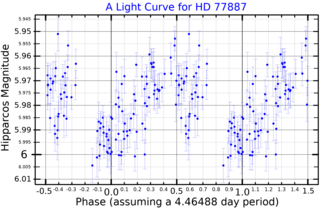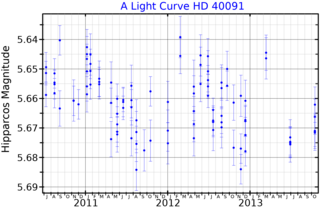Related Research Articles
HD 82205 is a solitary star in the southern constellation Antlia. It is faintly visible to the naked eye with an apparent magnitude of 5.48 and is estimated to be 810 light years distant based on parallax measurements. However, it is receding with a heliocentric radial velocity of 12 km/s.
HD 130458 is a double star in the southern circumpolar constellation of Apus. The pair has a combined apparent magnitude of 5.8, making it faintly visible to the naked eye under ideal conditions. Parallax measurements place the system 310-24 light years away and it is receding with a heliocentric radial velocity of 31.4 km/s.
HD 161988, also known as HR 6635, is a solitary, orange hued star located in the southern circumpolar constellation Apus. It has an apparent magnitude of 6.07, allowing it to be faintly visible to the naked eye. Parallax measurements place it at a distance of 621 light years, and it is currently receding with a heliocentric radial velocity of 36.8 km/s.
HD 131551 is a solitary star in the southern constellation Apus. It has an apparent magnitude of 6.19, allowing it to be faintly seen with the naked eye under ideal conditions. Located 526 light years away, the object is approaching the Sun with a heliocentric radial velocity of 7.6 km/s.
HD 152010 is a solitary star in the southern circumpolar constellation Apus. It has an apparent magnitude of 6.48, placing it near the max visibility for the naked eye. Located 1,006 light yearsaway, the object is approaching the Solar System with a heliocentric radial velocity of −15 km/s.
HD 30442 is a solitary star in the northern circumpolar constellation Camelopardalis. It is faintly visible to the naked eye with an apparent magnitude of 5.47 and is estimated to be 403 light years away from the Solar System. The object has a heliocentric radial velocity of −37 km/s, indicating that it is drifting closer.
HD 200661 is a solitary star in the equatorial constellation Equuleus. It has an apparent magnitude of 6.41, placing it near the max naked eye visibility. The star is situated at a distance of 430 light years but is approaching with a heliocentric radial velocity of −12.1 km/s.
HD 98176, also designated as HIP 55133 and rarely 22 G. Centauri, is a solitary, white hued star located in the southern constellation Centaurus. It has an apparent magnitude of 6.44, placing it near the limit for naked eye visibility. Based on parallax measurements from Gaia DR3, the object is estimated to be 348 light years distant. At its current distance, its brightness is diminished by 0.32 magnitudes due to interstellar dust. Pauzen et al. (2001) lists it as a potential λ Boötis star.
HD 121439, also known as HR 5240, is a solitary, bluish-white hued star located in the southern circumpolar constellation Apus. It has an apparent magnitude of 6.08, allowing it to be faintly visible to the naked eye. The object is located relatively far at a distance of 774 light years based on Gaia DR3 parallax measurements but is receding with a fairly constrained radial velocity of 4 km/s. At its current distance, HD 121439's brightness is diminished by 0.57 magnitudes due to interstellar dust.

HD 77887 is a solitary star located in the southern circumpolar constellation Volans. It has an apparent magnitude of 5.87, making it faintly visible to the naked eye if viewed under ideal conditions. The star is situated at a distance of about 760 light years but is receding with a heliocentric radial velocity of 12.6 km/s.
HD 22676 is a solitary star in the southern circumpolar constellation Mensa. It has an apparent magnitude of 5.67, making it faintly visible to the naked eye and is currently located at a distance of 333 light years. However, it is recceding from the sun with a radial velocity of 18.4 km/s.
HD 33875 is a solitary star in the southern circumpolar constellation Mensa. With an apparent magnitude of 6.26, it is barely visible to the naked eye under ideal conditions. The star is located at a distance of 421 light years but is receding at a rate of 8 km/s.

Pi2 Octantis, Latinized from π2 Octantis, is a solitary star situated in the southern circumpolar constellation Octans. It has an apparent magnitude of 5.64, allowing it to be faintly visible to the naked eye under ideal conditions. Located 1,570 light years away, the star is approaching the Sun with a heliocentric radial velocity of −13.8 km/s.
HD 64307, also known as HR 3075, is a solitary, orange hued star located in the northern circumpolar constellation Camelopardalis. It has an apparent magnitude of 5.35, allowing it to be faintly seen with the naked eye. Based on parallax measurements from the Gaia spacecraft, The object is estimated to be 690 light years distant. It appears to be receding from the Sun, having a heliocentric radial velocity of 34 km/s.
HD 200044 is a solitary star in the equatorial constellation Delphinus. It has an apparent magnitude of 5.7, allowing it to be faintly seen with the naked eye. The object is located 598 light years away, but is approaching the Solar System with a heliocentric radial velocity of −15.07 km/s.
HD 170069 is a solitary star in the southern constellation Telescopium. It has an apparent magnitude of 5.68, allowing it to be faintly seen with the naked eye. The star is located at a distance of 590 light years but is approaching closer with a heliocentric radial velocity of −18 km/s. HD 170069 was designated as Tau Telescopii before Benjamin Apthorp Gould dropped the title.
HD 208741, also known as HR 8380, is a yellowish-white hued star located in the southern circumpolar constellation Octans. It has an apparent magnitude of 5.91, making it faintly visible to the naked eye. Parallax measurements place it at a distance of 211 light years, and it is currently receding with a heliocentric radial velocity of 8 km/s.
HD 31529, also known as HR 1584, is a solitary, orange hued star located in the southern constellation Caelum, the chisel. It has an apparent magnitude of 6.09, making it faintly visible to the naked eye if viewed under ideal conditions. This object is located relatively far at a distance of 932 light years based on parallax measurements from Gaia DR3, but is receding with a heliocentric radial velocity of 28.4 km/s. Eggen (1989) lists it as a member of the old disk population.
HD 115088, also known as HIP 64951, is a star located in the southern circumpolar constellation Chamaeleon. It has an apparent magnitude of 6.33, placing it near the limit for naked eye visibility. Based on parallax measurements from the Gaia spacecraft, the object is estimated to be 412 light years distant. At that distance, its brightness is diminished by 0.37 magnitudes due to interstellar dust.

HD 40091, also known as HR 2082, is a solitary star located in the southern constellation Columba, the dove. It has an apparent magnitude of 5.54, making it faintly visible to the naked eye under ideal conditions. Based on parallax measurements from the Gaia spacecraft, the object is estimated to be 501 light years distant. However, it is rapidly receding with a high heliocentric radial velocity of 114 km/s.
References
- 1 2 3 4 5 6 Brown, A. G. A.; et al. (Gaia collaboration) (2021). "Gaia Early Data Release 3: Summary of the contents and survey properties". Astronomy & Astrophysics . 649: A1. arXiv: 2012.01533 . Bibcode:2021A&A...649A...1G. doi: 10.1051/0004-6361/202039657 . S2CID 227254300. (Erratum: doi:10.1051/0004-6361/202039657e). Gaia EDR3 record for this source at VizieR.
- 1 2 Høg, E.; Fabricius, C.; Makarov, V. V.; Urban, S.; Corbin, T.; Wycoff, G.; Bastian, U.; Schwekendiek, P.; Wicenec, A. (March 2000). "The Tycho-2 catalogue of the 2.5 million brightest stars". Astronomy and Astrophysics. 355: L27–L30. Bibcode:2000A&A...355L..27H. ISSN 0004-6361.
- 1 2 Cannon, Annie Jump; Pickering, Edward Charles (1923). "The Henry Draper catalogue : 19h and 20h". Annals of Harvard College Observatory. 98: 1. Bibcode:1923AnHar..98....1C.
- 1 2 Cousins, A. W. J. (16 November 1964). "Photometric Data for Stars in the Equatorial Zone (Seventh List)". Monthly Notes of the Astronomical Society of South Africa. 23: 175. Bibcode:1964MNSSA..23..175C. ISSN 0024-8266.
- 1 2 Famaey, B.; Jorissen, A.; Luri, X.; Mayor, M.; Udry, S.; Dejonghe, H.; Turon, C. (January 2005). "Local kinematics of K and M giants from CORAVEL/Hipparcos/Tycho-2 data. Revisiting the concept of superclusters". Astronomy and Astrophysics. 430: 165. arXiv: astro-ph/0409579 . Bibcode:2005A&A...430..165F. doi: 10.1051/0004-6361:20041272 . S2CID 17804304.
- ↑ Anderson, E.; Francis, Ch. (May 2012). "XHIP: An extended hipparcos compilation". Astronomy Letters. 38 (5): 331–346. arXiv: 1108.4971 . Bibcode:2012AstL...38..331A. doi:10.1134/S1063773712050015. ISSN 1063-7737. S2CID 119257644.
- 1 2 3 4 5 6 7 Liu, Y. J.; Tan, K. F.; Wang, L.; Zhao, G.; Sato, Bun'ei; Takeda, Y.; Li, H. N. (31 March 2014). "The Lithium Abundances of a Large Sample of Red Giants". The Astrophysical Journal. 785 (2): 94. arXiv: 1404.1687 . Bibcode:2014ApJ...785...94L. doi: 10.1088/0004-637X/785/2/94 . eISSN 1538-4357. ISSN 0004-637X.
- 1 2 Kervella, Pierre; Arenou, Frédéric; Thévenin, Frédéric (2022). "Stellar and substellar companions from Gaia EDR3". Astronomy & Astrophysics. 657: A7. arXiv: 2109.10912 . Bibcode:2022A&A...657A...7K. doi: 10.1051/0004-6361/202142146 . eISSN 1432-0746. ISSN 0004-6361.
- 1 2 McDonald, I.; Zijlstra, A. A.; Boyer, M. L. (21 November 2012). "Fundamental parameters and infrared excesses of Hipparcos stars: Parameters and IR excesses from Hipparcos". Monthly Notices of the Royal Astronomical Society. 427 (1): 343–357. arXiv: 1208.2037 . Bibcode:2012MNRAS.427..343M. doi: 10.1111/j.1365-2966.2012.21873.x . ISSN 0035-8711.
- 1 2 Anders, F.; et al. (August 2019). "Photo-astrometric distances, extinctions, and astrophysical parameters for Gaia DR2 stars brighter than G = 18". Astronomy & Astrophysics. 628: A94. arXiv: 1904.11302 . Bibcode:2019A&A...628A..94A. doi: 10.1051/0004-6361/201935765 . ISSN 0004-6361.
- ↑ "HR 7975". SIMBAD . Centre de données astronomiques de Strasbourg . Retrieved June 21, 2022.
- ↑ Gould, Benjamin Apthorp (1878). "Uranometria Argentina : brillantez y posicion de las estrellas fijas, hasta la septima magnitud, comprendidas dentro de cien grados del polo austral : con atlas". Resultados del Observatorio Nacional Argentino. 1. Bibcode:1879RNAO....1.....G.
- ↑ Mason, Brian D.; Wycoff, Gary L.; Hartkopf, William I.; Douglass, Geoffrey G.; Worley, Charles E. (December 2001). "The 2001 US Naval Observatory Double Star CD-ROM. I. The Washington Double Star Catalog". The Astronomical Journal. 122 (6): 3466–3471. Bibcode:2001AJ....122.3466M. doi: 10.1086/323920 . ISSN 0004-6256.